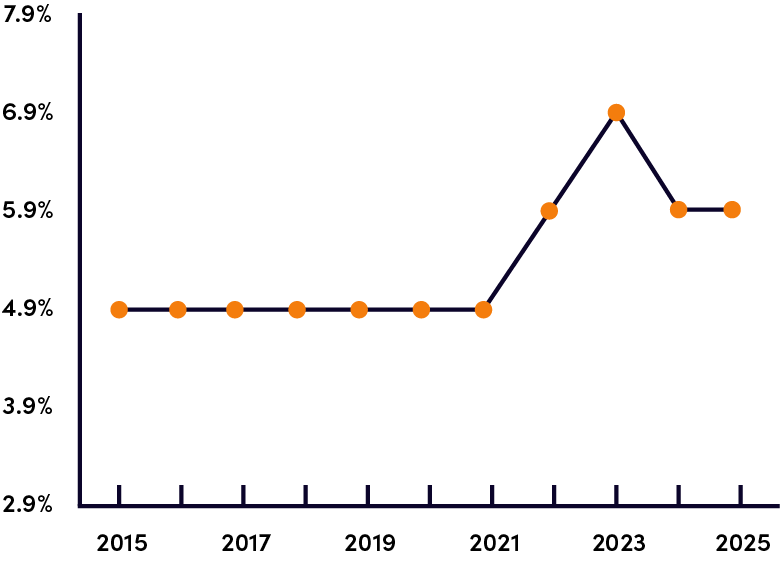Peak season looms. Demand surcharges take effect. And the General Rate Increase (GRI) is announced.
Per usual, FedEx and UPS have announced identical average GRIs, this time at 5.9% for the second year in a row.
While these have been lower than the 6.9% GRI shippers faced in 2023, rates are still increasing at a higher rate than most years in recent memory.
The Last 10 Years: GRI Trendline

Highlights:
| Surcharge | |
|---|---|
| Announced GRI | 5.9% |
| FedEx Residential Surcharge, Express | 6.5% |
| FedEx Residential Surcharge, Ground | 7.2% |
| FedEx Additional Handling | 26.6% Average |
| FedEx Oversize | 27.4% Average |
| UPS Residential Surcharge, Air | 5.7% |
| UPS Residential Surcharge, Ground | 8% |
| UPS Additional Handling | 26.9% Average |
| UPS Large Package Surcharge | 27.2% Average |
Unpacking the (True) Impact: 2025 FedEx GRI Analysis
Base Rate Increases
Base rates are the bulk of shipping costs, and while their increases are less severe than those applied to accessorials, they’ll still be the main driver of shipping spend increases in 2025.
FedEx is continuing their recent trend of signaling they prefer small, lightweight packages (the most profitable for them). Generally, higher weights and zones correlate with higher rate increases. For example, FedEx Ground rates are increasing by an average of 5.6% for Zone 2, but 6.8% for Zone 7.
| FedEx Service | Zone 2 Average Rate Increase | Zone 5 Average Rate Increase | Zone 7 Average Rate Increase |
|---|---|---|---|
| FedEx Ground & FedEx Home Delivery | 5.6% | 6.2% | 6.8% |
| FedEx Express Saver | 4.7% | 7.7% | 7.7% |
| FedEx 2 Day | 5.8% | 7.8% | 5.9% |
| FedEx 2 Day AM Package | 5.8% | 7.7% | 7.6% |
| FedEx Priority Overnight | 5.2% | 5.9% | 5.9% |
| FedEx Standard Overnight | 5.5% | 6.0% | 5.4% |
There’s another story being told through rate increases.
FedEx’s “Network 2.0” initiative to merge FedEx Express and Ground into a single operating unit is underway. A key piece of this move is to lean more on ground shipping, and certain rate increases suggest they’re nudging shippers in this direction.
In many cases, Express rates are increasing at higher rates for lower zones (with the exception of Zone 2), showing they’re punishing shippers for selecting an Express service when Ground could deliver the package in a similar timeframe.
Here’s an example:
| FedEx 2Day A.M. Average Increase by Zone | |
|---|---|
| Zones 3-5 | Zones 6-9 |
| 7.8% | 5.9% |
Accessorials
Like anything, the devil is in the details with the GRI.
And these are the details.
Accessorials aren’t factored into the “5.9%” average FedEx shared. This isn’t an accident, as all are seeing an increase higher than 5.9%.
As we mentioned above, FedEx prefers light, small packages. They’re easier to move, and in turn, more profitable.
Like the base rate increases, FedEx is using these to punish shippers who don’t ship the types of packages they want. If you ship heavy and/or bulky products (AKA “ugly freight”), look out for the Additional Handling & Oversize Charges – all increasing over 20%.
Zone-Based Additional Handling & Oversize Charges
| FedEx Surcharge | 2023 Rate | 2024 Rate | 2025 Rate | 2024 - 2025 Increase |
|---|---|---|---|---|
| Additional Handling (Weight) | ||||
| Zone 2 | $29 | $34.50 | $43.50 | 26.1% |
| Zone 3-4 | $31.50 | $37.50 | $47.50 | 26.7% |
| Zone 5-6 | $33.50 | $40 | $50.50 | 26.3% |
| Zone 7+ | $36 | $43.50 | $55 | 26.4% |
| Additional Handling (Dimension) | ||||
| Zone 2 | $18.50 | $22 | $28 | 27.3% |
| Zone 3-4 | $20.50 | $24.50 | $31 | 26.3% |
| Zone 5-6 | $22.50 | $27 | $34 | 25.9% |
| Zone 7+ | $25 | $30 | $38 | 26.7% |
| Additional Handling (Packaging) | ||||
| Zone 2 | $16.50 | $19.50 | $25 | 28.2% |
| Zone 3-4 | $19 | $23 | $29 | 26.1% |
| Zone 5-6 | $20 | $24 | $30.50 | 27.1% |
| Zone 7+ | $21 | $25 | $31.50 | 26% |
| Oversize (Express/Ground) | ||||
| Zone 2 | $135 | $160 | $205 | 28.1% |
| Zone 3-4 | $145 | $175 | $225 | 28.6% |
| Zone 5-6 | $160 | $190 | $240 | 26.3% |
| Zone 7+ | $170 | $205 | $260 | 26.8% |
| Oversize (Home Delivery) | ||||
| Zone 2 | $160 | $190 | $240 | 26.3% |
| Zone 3-4 | $170 | $205 | $260 | 26.8% |
| Zone 5-6 | $190 | $230 | $290 | 26.1% |
| Zone 7+ | $200 | $240 | $305 | 27.1% |
Back to FedEx’s list of “most profitable” packages – commercial deliveries are much cheaper than residential, especially residential deliveries in rural areas (which are eligible for the Delivery Area Surcharge). As a result, eCommerce companies need to prepare for these fees:
FedEx Residential Delivery Surcharge
| FedEx Residential Delivery Fees | 2023 Rate | 2024 Rate | 2025 Rate | 2024 - 2025 Increase |
|---|---|---|---|---|
| FedEx Ground | $5.50 | $5.55 | $5.95 | 7.2% |
| FedEx Express | $5.80 | $6.15 | $6.55 | 6.5% |
FedEx Delivery Area Surcharge
| FedEx Delivery Area Surcharges | 2023 Rate | 2024 Rate | 2025 Rate | 2024 - 2025 Increase |
|---|---|---|---|---|
| U.S. Express Package Services (Residential) | $5.55 | $5.85 | $6.20 | 6% |
| U.S. Express Package Services (Commercial) | $3.70 | $3.95 | $4.20 | 6.3% |
| U.S. Ground Services (Residential) | $5.30 | $5.70 | $6.20 | 8.8% |
| Maximum Charge with FedEx Express Multiweight Pricing (Commercial) | $18.50 | $19.75 | $21 | 6.3% |
| Maximum Charge with FedEx Express Multiweight Pricing (Residential) | $27.75 | $29.25 | $31 | 6% |
| Maximum Charge with FedEx Ground Multiweight Pricing (Commercial) | $18.50 | $19.75 | $21 | 6.3% |
Unpacking the (True) Impact: 2025 UPS GRI Analysis
Base Rate Increases
Lower zones are doing heavy lifting to lower the overall increase average, with all but one of the services we analyzed below having a Zone 2 increase lower than 5.9%.
While not a hard rule, higher weights and zones tend to correlate with higher increases on UPS’ base rates, much like FedEx.
An optimized network (to avoid shipping to higher zones) is key to mitigating a GRI’s impact, especially if you use a lot of UPS’ air services. For example, UPS 2 Day rates for Zone 7 are increasing by an average of 7.8%, nearly two percentage points higher than the announced GRI.
| UPS Service | Zone 2 Average Rate Increase | Zone 5 Average Rate Increase | 2025 Rate |
|---|---|---|---|
| UPS Ground | 6% | 5.5% | 5.8% |
| UPS Next Day Air Early | 3.9% | 5.9% | 5.9% |
| UPS Next Day Air | 4.7% | 6.3% | 6.3% |
| UPS Next Day Air Saver | 4.6% | 6.2% | 5.8% |
| UPS 2nd Day Air A.M. | 5% | 6.7% | 6.7% |
| UPS 2nd Day Air | 5.7% | 7.1% | 7.8% |
Accessorials
Many accessorials are increasing more than 5.9%, and like FedEx, UPS is rapidly increasing the cost to ship large packages through Additional Handling and Large Package surcharges.
One very important note this year – UPS has introduced a minimum billable weight of 40 lbs for any packages that receive the Additional Handling Surcharge for dimensions. If a package triggers this surcharge, and weighs less than 40 lbs (whether that’s real or DIM weight), the base rate for a 40-lb package will be applied.
| UPS Surcharge | 2023 Rate | 2024 Rate | 2025 Rate | 2024 - 2025 Increase |
|---|---|---|---|---|
| Additional Handling (Weight) | ||||
| Zone 2 | $29 | $34.50 | $43.50 | 26.1% |
| Zone 3-4 | $31.50 | $37.50 | $47.50 | 26.7% |
| Zone 5+ | $34.50 | $41.50 | $52.75 | 27.1% |
| Additional Handling (Dimension) | ||||
| Zone 2 | $18.50 | $22 | $28 | 27.3% |
| Zone 3-4 | $20.50 | $24.50 | $31 | 26.5% |
| Zone 5+ | $23.50 | $28.25 | $36 | 27.4% |
| Additional Handling (Packaging) | ||||
| Zone 2 | $16.50 | $19.50 | $25 | 28.2% |
| Zone 3-4 | $19 | $23 | $29 | 26.1% |
| Zone 5+ | $20.50 | $24.50 | $31 | 26.5% |
| Large Package (Commercial) | ||||
| Zone 2 | $135 | $160 | $205 | 28.1% |
| Zone 3-4 | $145 | $175 | $225 | 28.6% |
| Zone 5+ | $165 | $197.50 | $250 | 26.6% |
| Large Package (Residential) | ||||
| Zone 2 | $160 | $190 | $240 | 26.3% |
| Zone 3-4 | $170 | $205 | $260 | 26.8% |
| Zone 5+ | $195 | $235 | $297.50 | 26.6% |
Just like FedEx (again), UPS doesn’t like inefficient delivery destinations – mainly residential addresses, rural locations, and dense urban areas.
If you ship frequently to any of the above, keep an eye out for these surcharges.
UPS Residential Delivery Surcharge
| UPS Residential Surcharge | 2023 Rate | 2024 Rate | 2025 Rate | 2024 - 2025 Increase |
|---|---|---|---|---|
| Ground | $5.25 | $5.65 | $6.10 | 8% |
| Air | $5.85 | $6.20 | $6.55 | 5.7% |
UPS Delivery Area Surcharge
| UPS Delivery Area Surcharges | 2023 Rate | 2024 Rate | 2025 Rate | 2024 - 2025 Increase |
|---|---|---|---|---|
| UPS Ground (Commercial) | $3.70 | $3.95 | $4.20 | 6.3% |
| UPS Ground (Residential) | $5.30 | $5.85 | $6.15 | 5.1% |
| UPS Air (Commercial) | $3.70 | $3.95 | $4.20 | 6.3% |
| UPS Air (Residential) | $5.55 | $5.70 | $6.15 | 7.9% |
Building Your 2025 Playbook
Step #1 Get an Accurate Picture of What the GRI Means for You
The 5.9% average general rate increase is just that. General – an average of the base rate increases across the board. So if you’re just running with “5.9% increase” for budgeting, it won’t be accurate. You need to dive into the data to see how the rate hikes will affect your shipping profile.
Start with comparing your current landed cost against your landed cost after the 2025 general rate increases.
This is the total amount it costs to create a product, transport it, and have the customer receive it.
A few essential metrics you need:
- Average zone
- Average price/pack
- Total accessorial charges
- Shipping charges by service type
- Spend trends
- Carrier agreement terms and discounts
These costs add up quickly. Especially when it comes to accessorial charges. For example, with FedEx, to ship a one-pound package via ground, you could incur base transportation costs, plus:
- A residential surcharge (7.2% higher in 2025)
- A dimensional weight charge (higher than your actual weight charge would be)
- A delivery area surcharge (8.8% higher in 2024)
Heads up. Your carriers are tracking these metrics and using them to their advantage. They know your profile well and have their own profits in mind.
If you want to ease the blow of these increases, you need to think as the carrier thinks and ship like they want you to ship.
If you’re feeling overwhelmed or crunched for time, you’re not alone. Software like SiftedAI can model these changes for you.
Step #2 Build a Plan to Minimize Impact
Don’t give carriers the upper hand. While you can’t hide your shipping profile from them, you can use your data to identify inefficiencies and make changes.
View your carrier as an ally during negotiations
You can work together with your carrier representative to find how you can help them be more efficient so they can help your efficiency in return. Use step #1 to run the numbers and find where the GRI will hit you the hardest. Then identify areas of leverage and negotiate based on your shipping profile.
Analyze your carrier agreement for hidden fees and surcharges. (Read the fine print!)
Sift through your agreement to find any minimum spending clauses. You may have negotiated a discount that decreases your shipping costs, but does it offset the deal if there’s a shipping minimum?
Consider internal adjustments to offset costs
- Pass additional shipping costs onto your customers
- Downgrade to cheaper shipping with longer transit times
- Work with regional carriers and expand your carrier mix
- Explore other ways to offset surcharges like box optimization or zone skipping
- Find ways to maximize in-region fulfillment
Get Ahead of the GRI Before It Gets Ahead of You
With SiftedAI, you can analyze exactly how the GRI increases will affect you.
There is an entire dashboard dedicated to doing just that.
To take it a step further, use Sifted decision support tools to run advanced modeling scenarios. It will help you recognize when to:
- Eliminate unnecessary spending: Be notified of avoidable mistakes that are costing you, and ensure you’re continuously finding all possible savings
- Open a new distribution center: Your origin optimization has to be a top priority, given that base rates and surcharges alike are zone-based
- Add regional or LTL carriers to your mix: You shouldn’t rely solely on UPS and FedEx. Explore regional carriers or new national challengers like USPS Ground Advantage or Amazon Shipping
- Re-evaluate appropriate packaging: Are you getting hit hard with accessorials? Looking at you large packages.
Don’t let the GRI slow you down – or catapult you deep into the red. Sifted has the insights you need to stay ahead of the carriers and your competition.











